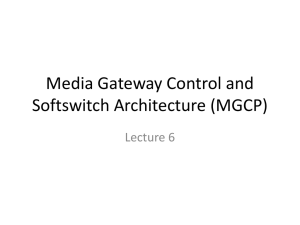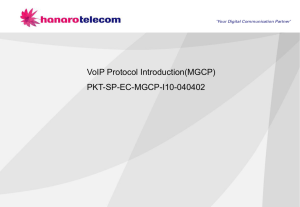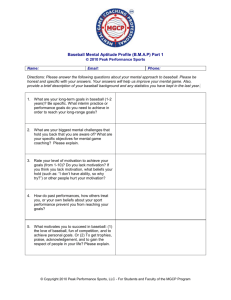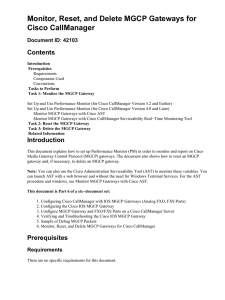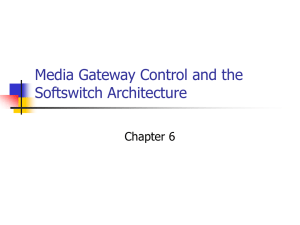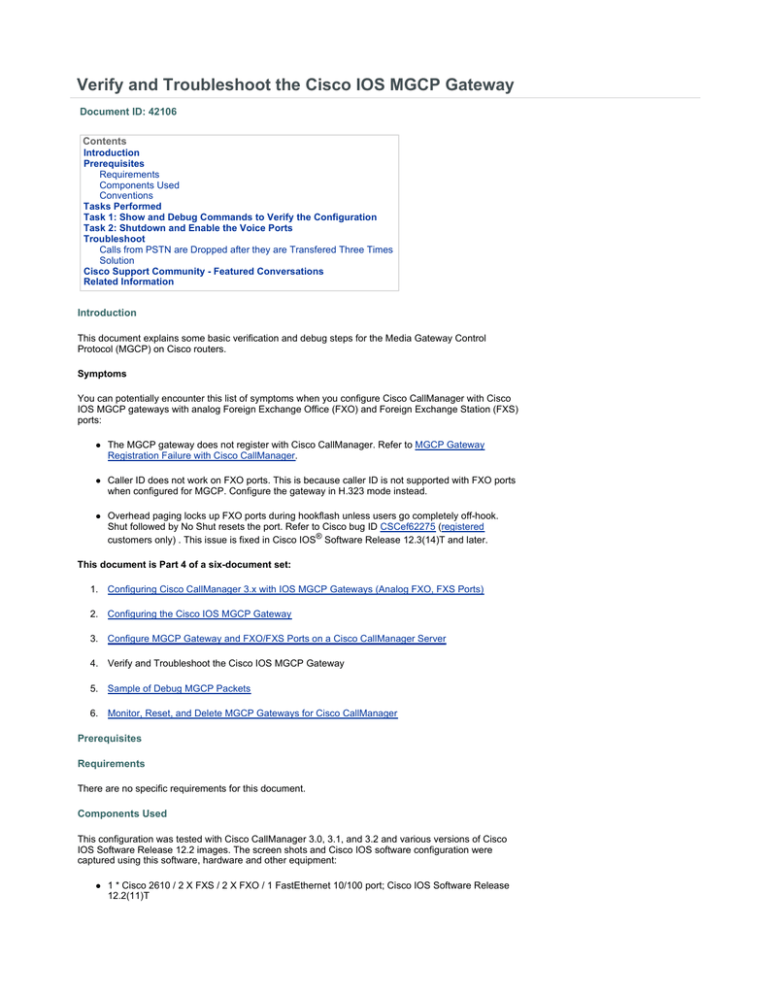
Verify and Troubleshoot the Cisco IOS MGCP Gateway
Document ID: 42106
Contents
Introduction
Prerequisites
Requirements
Components Used
Conventions
Tasks Performed
Task 1: Show and Debug Commands to Verify the Configuration
Task 2: Shutdown and Enable the Voice Ports
Troubleshoot
Calls from PSTN are Dropped after they are Transfered Three Times
Solution
Cisco Support Community - Featured Conversations
Related Information
Introduction
This document explains some basic verification and debug steps for the Media Gateway Control
Protocol (MGCP) on Cisco routers.
Symptoms
You can potentially encounter this list of symptoms when you configure Cisco CallManager with Cisco
IOS MGCP gateways with analog Foreign Exchange Office (FXO) and Foreign Exchange Station (FXS)
ports:
The MGCP gateway does not register with Cisco CallManager. Refer to MGCP Gateway
Registration Failure with Cisco CallManager.
Caller ID does not work on FXO ports. This is because caller ID is not supported with FXO ports
when configured for MGCP. Configure the gateway in H.323 mode instead.
Overhead paging locks up FXO ports during hookflash unless users go completely off-hook.
Shut followed by No Shut resets the port. Refer to Cisco bug ID CSCef62275 (registered
customers only) . This issue is fixed in Cisco IOS® Software Release 12.3(14)T and later.
This document is Part 4 of a six-document set:
1. Configuring Cisco CallManager 3.x with IOS MGCP Gateways (Analog FXO, FXS Ports)
2. Configuring the Cisco IOS MGCP Gateway
3. Configure MGCP Gateway and FXO/FXS Ports on a Cisco CallManager Server
4. Verify and Troubleshoot the Cisco IOS MGCP Gateway
5. Sample of Debug MGCP Packets
6. Monitor, Reset, and Delete MGCP Gateways for Cisco CallManager
Prerequisites
Requirements
There are no specific requirements for this document.
Components Used
This configuration was tested with Cisco CallManager 3.0, 3.1, and 3.2 and various versions of Cisco
IOS Software Release 12.2 images. The screen shots and Cisco IOS software configuration were
captured using this software, hardware and other equipment:
1 * Cisco 2610 / 2 X FXS / 2 X FXO / 1 FastEthernet 10/100 port; Cisco IOS Software Release
12.2(11)T
1 * Cisco CallManager 4.1(0.91) running on an MCS7835
2 * Analog handsets
2 * Cisco 7960 IP Phones
The information in this document was created from the devices in a specific lab environment. All of the
devices used in this document started with a cleared (default) configuration. If your network is live,
make sure that you understand the potential impact of any command.
Refer to the Cisco CallManager Compatibility Matrix for recommended compatibility software versions
between Cisco CallManager and the Cisco IOS gateway.
Note: Cisco IOS Software Release 12.2(11)T or later is recommended based on the ccm-manager
command enhancements. The ccm-manager command requires Cisco IOS Software Release 12.1(5)
XM or later on all routers (Cisco 2600 and 3600) and the Cisco Voice Gateway 200 (VG200).
The 2600 and 3600 routers support MGCP if they are running Cisco IOS Software Release 12.1(3)T or
later. The release and version that you require are based on the features that you need to enable. The
Cisco CallManager server must be running version 3.0(5)a or later. The router configuration is the same
for all types of routers. The Cisco CallManager configuration is also the same for all types of routers.
The VG200 is supported by Cisco IOS Software Release 12.1(5)XM1 and later releases. The release
and version that you require are based on the features that you need to enable. Although the VG200 is
supported in earlier releases of Cisco CallManager, version 3.0(5)a or later is recommended.
Conventions
Refer to Cisco Technical Tips Conventions for more information on document conventions.
Tasks Performed
Task 1: Show and Debug Commands to Verify the Configuration
Task 2: Shutdown and Enable the Voice Ports
Task 1: Show and Debug Commands to Verify the Configuration
These steps do not need to be performed in the order in which they appear. The show commands are
useful because they display the current status of the configuration as well as verify that the changes
that you made took effect.
show ccm-manager
This command verifies the active and redundant configured Cisco CallManager servers. It also
indicates if the gateway is currently registered with the Cisco CallManager.
Note: This show ccm-manager command output was captured in a separated environment.
psy-voice-01#show ccm-manager
MGCP Domain Name: psy-voice-01
Priority
Status
Host
============================================================
Primary
First Backup
Second Backup
Registered
None
None
10.89.129.211
Current active Call Manager: 10.89.129.211
Backhaul/Redundant link port: 2428
Failover Interval: 30 seconds
Keepalive Interval: 15 seconds
Last keepalive sent: 5w1d (elapsed time: 00:00:04)
Last MGCP traffic time: 5w1d (elapsed time: 00:00:04)
Last failover time: None
Switchback mode: Graceful
MGCP Fallback mode: Not Selected
Last MGCP Fallback start time: 00:00:00
Last MGCP Fallback end time: 00:00:00
Configuration Error History:
show mgcp
Use this command to verify the status of the router MGCP parameters. You should see the IP
address of the Cisco CallManager server that you use (10.89.129.211, in this case.) All the
other parameters are left at their default behavior in this configuration.
psy-voice-01#show mgcp
MGCP Admin State ACTIVE, Oper State ACTIVE - Cause Code NONE
MGCP call-agent: 10.89.129.211 Initial protocol service is MGCP 0.1
MGCP block-newcalls DISABLED
MGCP send SGCP RSIP: forced/restart/graceful/disconnected DISABLED
MGCP quarantine mode discard/step
MGCP quarantine of persistent events is ENABLED
MGCP dtmf-relay voip codec all mode out-of-band
MGCP dtmf-relay for VoAAL2 disabled for all codec types
MGCP voip modem passthrough disabled
MGCP voaal2 modem passthrough disabled
MGCP voip modem relay: Disabled.
MGCP TSE payload: 100
MGCP T.38 Named Signalling Event (NSE) response timer: 200
MGCP Network (IP/AAL2) Continuity Test timer: 200
MGCP 'RTP stream loss' timer: 5
MGCP request timeout 500
MGCP maximum exponential request timeout 4000
MGCP gateway port: 2427, MGCP maximum waiting delay 3000
MGCP restart delay 0, MGCP vad DISABLED
MGCP rtrcac DISABLED
MGCP system resource check DISABLED
MGCP xpc-codec: DISABLED, MGCP persistent hookflash: DISABLED
MGCP persistent offhook: ENABLED, MGCP persistent onhook: DISABLED
MGCP piggyback msg ENABLED, MGCP endpoint offset DISABLED
MGCP simple-sdp DISABLED
MGCP undotted-notation DISABLED
MGCP codec type g711ulaw, MGCP packetization period 20
MGCP JB threshold lwm 30, MGCP JB threshold hwm 150
MGCP LAT threshold lwm 150, MGCP LAT threshold hwm 300
MGCP PL threshold lwm 1000, MGCP PL threshold hwm 10000
MGCP CL threshold lwm 1000, MGCP CL threshold hwm 10000
MGCP playout mode is adaptive 60, 4, 200 in msec
MGCP media (RTP) dscp: ef, MGCP signaling dscp: af31
MGCP default package: line-package
MGCP supported packages: gm-package dtmf-package trunk-package linepackage
hs-package atm-package ms-package dt-package
res-package
mt-package
MGCP Digit Map matching order: shortest match
SGCP Digit Map matching order: always left-to-right
MGCP VoAAL2 ignore-lco-codec DISABLED
MGCP T.38 Fax is ENABLED
MGCP T.38 Fax ECM is DISABLED
MGCP T.38 Fax NSF Override is DISABLED
MGCP T.38 Fax Low Speed Redundancy: 0MGCP T.38 Fax High Speed
Redundancy: 0
MGCP Upspeed payload type for G711ulaw: 0, G711alaw: 8
MGCP Dynamic payload type for G.726-16K codec
MGCP Dynamic payload type for G.726-24K codec
MGCP Dynamic payload type for G.Clear codec
Explanation of Fields in show mgcp Command
Output
Field
Description
MGCP Admin
State...Oper State
The administrative and
operational state of the
MGCP daemon. The
administrative state controls
start and stop of the
application using the mgcp
and mgcp block-newcalls
commands. The operational
state controls normal MGCP
operations.
MGCP call-agent
The address of the call agent
specified in the mgcp callagent or call-agent
command and the protocol
initiated for this session.
MGCP blocknewcalls
The state of the mgcp
block-newcalls command.
MGCP send SGCP
RSIP...disconnected
The setting for the mgcp
sgcp restart notify and the
mgcp sgcp disconnected
notify commands (ENABLED
or DISABLED).
MGCP quarantine
mode
How the quarantine buffer is
to handle Simple Gateway
Control Protocol (SGCP)
events.
MGCP quarantine of Whether SGCP persistent
persistent events
events are handled by the
is
quarantine buffer.
MGCP dtmf-relay
The setting for the mgcp
dtmf-relay command.
MGCP voip modem
passthrough
The settings for mode,
codec, and redundancy from
the mgcp modem
passthrough mode, mgcp
modem passthrough
codec, and mgcp modem
passthrough voip
redundancy commands.
MGCP voaal2 modem
passthrough
The settings for mode,
codec, and redundancy from
the mgcp modem
passthrough mode and
mgcp modem passthrough
codec commands.
MGCP TSE payload
The setting for the mgcp tse
payload command.
MGCP Network
(IP/AAL2)
Continuity Test
The setting for the net-conttest keyword in the mgcp
timer command.
timer
MGCP 'RTP stream
loss' timer
The setting for the receivertcp keyword in the mgcp
timer command.
MGCP request
timeout
The setting for the mgcp
request timeout command.
MGCP maximum
exponential
request timeout
The setting for the mgcp
request timeout max
command.
MGCP gateway port
The User Datagram Protocol
(UDP) port specification for
the gateway.
MGCP maximum
waiting delay
The setting for the mgcp
max-waiting-delay
command.
MGCP restart delay
The setting for the mgcp
restart-delay command.
MGCP vad
The setting for the mgcp
vad command.
MGCP rtrcac
Whether MGCP Service
Assurance Agent (SAA) Call
Admission Control (CAC)
has been enabled with the
mgcp rtrcac command.
MGCP system
resource check
Whether MGCP System
Resource Check (SRC) CAC
has been enabled with the
mgcp src-cac command.
MGCP xpc-codec
Whether the mgcp sdp xpccodec command has been
configured to generate the Xpc-codec field for Session
Description Protocol (SDP)
codec negotiation in
Network-based Call
Signaling (NCS) and
Trunking Gateway Control
Protocol (TGCP).
MGCP persistent
hookflash
Whether the mgcp
persistent hookflash
command has been
configured to send persistent
hookflash events to the call
agent.
MGCP persistent
offhook
Whether the mgcp
persistent offhook
command has been
configured to send persistent
offhook events to the call
agent.
MGCP persistent
onhook
Whether the mgcp
persistent onhook
command has been
configured to send persistent
onhook events to the call
agent.
Whether the mgcp
piggyback message
MGCP piggyback msg command has been
configured to enable
piggyback messaging.
MGCP endpoint
offset
Whether the mgcp endpoint
offset command has been
configured to enable
incrementing of the local
portion of an endpoint name
for NCS. The local portion
contains the analog or digital
voice port identifier.
MGCP simple-sdp
Whether the mgcp sdp
simple command has been
configured to enable simple
mode SDP operation.
MGCP undotted
notation
Whether the mgcp sdp
notation undotted
command has been
configured to enable
undotted SDP notation for
the codec string.
MGCP codec type
The setting for the mgcp
codec command.
MGCP packetization The packetization period
parameter setting for the
period
mgcp codec command.
MGCP JB threshold
lwm
The jitter-buffer minimumthreshold parameter setting
for the mgcp qualitythreshold command.
MGCP JB threshold
hwm
The jitter-buffer maximumthreshold parameter setting
for the mgcp qualitythreshold command.
The latency minimumMGCP LAT threshold threshold parameter setting
lwm
for the mgcp qualitythreshold command.
The latency maximumMGCP LAT threshold threshold parameter setting
hwm
for the mgcp qualitythreshold command.
MGCP PL threshold
lwm
The packet-loss minimumthreshold parameter setting
for the mgcp qualitythreshold command.
MGCP PL threshold
hwm
The packet-loss maximumthreshold parameter setting
for the mgcp qualitythreshold command.
MGCP CL threshold
lwm
The cell-loss minimumthreshold parameter setting
for the mgcp qualitythreshold command.
MGCP CL threshold
hwm
The cell-loss maximumthreshold parameter setting
for the mgcp qualitythreshold command.
MGCP playout mode
is
The jitter-buffer packet type
and size.
MGCP IP ToS low
delay
The low-delay parameter
setting for the mgcp ip-tos
command.
MGCP IP ToS high
throughput
The high-throughput
parameter setting for the
mgcp ip-tos command.
MGCP IP ToS high
reliability
The high-reliability
parameter setting for the
mgcp ip-tos command.
MGCP IP ToS low
cost
The low-cost parameter
setting for the mgcp ip-tos
command.
MGCP IP RTP
precedence
The rtp precedence
parameter setting for the
mgcp ip-tos command.
MGCP signaling
The signaling precedence
precedence
parameter setting for the
mgcp ip-tos command.
MGCP default
package
The package configured as
the default package with the
mgcp default-package
command.
MGCP supported
packages
Packages configured with
the mgcp packagecapability command to be
supported on this gateway in
this session. The lcr-package
display is new in Cisco IOS
Software Release 12.3(8)T.
Settings for the mgcp fax
t.38 command. These values
are displayed:
MGCP T.38 Fax
MGCP T.38 fax:
ENABLED or
DISABLED.
Error correction mode
(ECM): ENABLED or
DISABLED.
Nonstandard facilities
(NSF) override:
ENABLED or
DISABLED. If
enabled, the override
code is displayed.
MGCP T.38 fax lowspeed redundancy:
the factor set on the
gateway for
redundancy.
MGCP T.38 fax highspeed redundancy:
the factor set on the
gateway for
redundancy.
show mgcp endpoint
Use this command to show the voice ports (endpoints) that are under MGCP control in the
router. This command verifies which voice ports have been bound to the MGCP application. This
is related to the application MGCPAPP command and the port commands that were entered
under the plain old telephone service (POTS) dial peers in the document Configuring the Cisco
IOS MGCP Gateway.
psy-voice-01#show mgcp endpoint
aaln/S1/SU0/0@psy-voice-01
aaln/S1/SU0/1@psy-voice-01
aaln/S1/SU1/0@psy-voice-01
aaln/S1/SU1/1@psy-voice-01
show mgcp connection
Use this command to display any active MGCP connections. The endpoint is Slot1/Module
0/Port 0. This corresponds to the MGCP Member Configuration identifier in Cisco CallManager.
This tells you which port on the router is the endpoint in the call.
IThere is one active call in this command output:
psy-voice-01#show mgcp connection
Endpoint
Call_ID(C) Conn_ID(I) (P)ort (M)ode (S)tate (CO)dec
(E)vent[SIFL] (R)esult[EA]
1. aaln/S1/SU0/0
C=A00000000100007c000000F5,14,15 I=0x6 P=
17068,19094
M=3 S=4,4 CO=1 E=2,10,0,2 R=0,0
Explanation of Fields in show mgcp connection
Command Output
Endpoint
The endpoint for each call shown in the
digital endpoint naming convention of slot
number (S0) and digital line (DS1-0)
number (1).
Call_ID
(C)
The MGCP call ID sent by the call agent,
the internal call control application
programming interface (CCAPI) call ID for
this endpoint, and the peer call legs CCAPI
call ID. (CCAPI is an application
programming interface [API] to provide call
control facilities to applications.)
Conn_ID
(I)
The connection ID generated by the
gateway and sent in the acknowledgment
message.
(P)ort
The ports used for this connection. The
first port is the local UDP port. The second
port is the remote UDP port.
(M)ode
The call mode, for which: 0—Indicates an
invalid value for mode. 1—Indicates the
gateway should only send packets. 2—
Indicates the gateway should only receive
packets. 3—Indicates the gateway can
send and receive packets. 4—Indicates
the gateway should neither send nor
receive packets. 5—Indicates the gateway
should place the circuit in loopback mode.
6—Indicates the gateway should place the
circuit in test mode. 7—Indicates the
gateway should use the circuit for network
access for data. 8—Indicates the gateway
should place the connection in network
loopback mode. 9—Indicates the gateway
should place the connection in network
continuity test mode. 10—Indicates the
gateway should place the connection in
conference mode. All other values are
used for internal debug purposes.
(S)tate
The call state. The values are used for
internal debug purposes.
(C)odec
The codec identifier. The values are used
for internal debug purposes.
(E)vent
[SIFL]
Used for internal debug purposes.
(R)esult
Used for internal debug purposes.
[EA]
show voice port mod_number/slot_number/port_number
Use this command to verify the current status and configuration of the voice ports on the router.
This is sample output from the show voice port command for an FXO voice port:
psy-voice-01#show voice port 1/1/0
Foreign Exchange Office 1/1/0 Slot is 1, Sub-unit is 1, Port is 0
Type of VoicePort is FXO
Operation State is DORMANT
Administrative State is UP
No Interface Down Failure
Description is not set
Noise Regeneration is enabled
Non Linear Processing is enabled
Non Linear Mute is disabled
Non Linear Threshold is -21 dB
Music On Hold Threshold is Set to -38 dBm
In Gain is Set to 0 dB
Out Attenuation is Set to 3 dB
Echo Cancellation is enabled
Echo Cancellation NLP mute is disabled
Echo Cancellation NLP threshold is -21 dB
Echo Cancel Coverage is set to 8 ms
Playout-delay Mode is set to adaptive
Playout-delay Nominal is set to 60 ms
Playout-delay Maximum is set to 200 ms
Playout-delay Minimum mode is set to default, value 40 ms
Playout-delay Fax is set to 300 ms
Connection Mode is normal
Connection Number is not set
Initial Time Out is set to 10 s
Interdigit Time Out is set to 10 s
Call Disconnect Time Out is set to 60 s
Ringing Time Out is set to 180 s
Wait Release Time Out is set to 30 s
Companding Type is u-law
Region Tone is set for US
Analog Info Follows:
Currently processing none
Maintenance Mode Set to None (not in mtc mode)
Number of signaling protocol errors are 0
Impedance is set to 600r Ohm
Station name None, Station number None
Translation profile (Incoming):
Translation profile (Outgoing):
Voice card specific Info Follows:
Signal Type is loopStart
Battery-Reversal is enabled
Number Of Rings is set to 1
Supervisory Disconnect is signal
Answer Supervision is inactive
Hook Status is On Hook
Ring Detect Status is inactive
Ring Ground Status is inactive
Tip Ground Status is inactive
Dial Out Type is dtmf
Digit Duration Timing is set to 100 ms
InterDigit Duration Timing is set to 100 ms
Pulse Rate Timing is set to 10 pulses/second
InterDigit Pulse Duration Timing is set to 750 ms
Percent Break of Pulse is 60 percent
GuardOut timer is 2000 ms
Note: FXO ports in loopstart mode normally disconnect calls when they detect a second battery
reversal (back to normal). Use the no battery-reversal command on FXO ports to disable this
action. If an FXO port or its peer FXS port does not support battery reversal, avoid configuring
battery-reversal or battery-reversal answer on the FXO port. On FXO ports that do not
support battery reversal, the battery-reversal command can cause unpredictable behavior,
while the battery-reversal answer command prevents calls from being answered. Use the no
battery-reversal command to ensure that battery reversal answer is disabled on FXO ports that
do not support battery reversal.
Note: This example disables battery reversal on voice port 1/1/0 on a router.
voice-port 1/1/0
no battery-reversal
This is sample output from the show voice port command for an FXS voice port:
psy-voice-01#show voice port 1/0/0
Foreign Exchange Station 1/0/0 Slot is 1, Sub-unit is 0, Port is 0
Type of VoicePort is FXS
Operation State is UP
Administrative State is UP
No Interface Down Failure
Description is not set
Noise Regeneration is enabled
Non Linear Processing is enabled
Non Linear Mute is disabled
Non Linear Threshold is -21 dB
Music On Hold Threshold is Set to -38 dBm
In Gain is Set to 0 dB
Out Attenuation is Set to 3 dB
Echo Cancellation is enabled
Echo Cancellation NLP mute is disabled
Echo Cancellation NLP threshold is -21 dB
Echo Cancel Coverage is set to 8 ms
Playout-delay Mode is set to adaptive
Playout-delay Nominal is set to 60 ms
Playout-delay Maximum is set to 200 ms
Playout-delay Minimum mode is set to default, value 40 ms
Playout-delay Fax is set to 300 ms
Connection Mode is normal
Connection Number is not set
Initial Time Out is set to 10 s
Interdigit Time Out is set to 10 s
Call Disconnect Time Out is set to 60 s
Ringing Time Out is set to 180 s
Wait Release Time Out is set to 30 s
Companding Type is u-law
Region Tone is set for US
Analog Info Follows:
Currently processing unknown
Maintenance Mode Set to None (not in mtc mode)
Number of signaling protocol errors are 0
Impedance is set to 600r Ohm
Station name None, Station number None
Translation profile (Incoming):
Translation profile (Outgoing):
Voice card specific Info Follows:
Signal Type is loopStart
Ring Frequency is 25 Hz
Hook Status is Off Hook
Ring Active Status is inactive
Ring Ground Status is inactive
Tip Ground Status is inactive
Digit Duration Timing is set to 100 ms
InterDigit Duration Timing is set to 100 ms
No disconnect acknowledge
Ring Cadence is defined by CPTone Selection
Ring Cadence are [20 40] * 100 msec
Ringer Equivalence Number is set to 1
Explanation of Fields in show voice port Command
Output
Administrative
State
Administrative state of the
voice port.
Alias
User-supplied alias for this
voice port.
Clear Wait
Time of inactive seizure signal
Duration Timing
to declare call cleared.
Connection Mode
Connection mode of the
interface.
Connection
Number
Full E.164 (ITU-T) telephone
number used to establish a
connection with the trunk or
private line, automatic
ringdown (PLAR) mode.
Currently
processing
Type of call currently being
processed: none, voice, or fax.
Delay Duration
Timing
Maximum delay signal duration
for delay dial signaling.
Delay Start
Timing
Timing of generation of
delayed start signal from
detection of incoming seizure.
Dial Type
Out-dialing type of the voice
port.
Digit Duration
Timing
Dual tone multifrequency
(DTMF) digit duration in
milliseconds.
E&M Type
Type of ear and mouth (E&M)
interface.
Echo Cancel
Coverage
Echo cancel coverage for this
port.
Echo
Cancellation
Whether echo cancellation is
enabled for this port.
Hook Flash
Duration Timing
Maximum length of hook flash
signal.
Hook Status
Hook status of the FXO/FXS
interface.
Impedance
Configured terminating
impedance for the E&M
interface.
In Gain
Amount of gain inserted at the
receiver side of the interface.
In Seizure
Incoming seizure state of the
E&M interface.
Initial Time Out
Amount of time the system
waits for an initial input digit
from the caller.
InterDigit
Duration Timing
DTMF interdigit duration in
milliseconds.
InterDigit Pulse
Duration Timing
Pulse dialing interdigit timing in
milliseconds.
Interdigit Time
Out
Amount of time the system
waits for a subsequent input
digit from the caller.
Maintenance Mode
Maintenance mode of the
voice port.
Music On Hold
Threshold
Configured Music On Hold
threshold value for this
interface.
Noise
Regeneration
Whether background noise
should be played to fill silent
gaps if voice activity detection
(VAD) is activated.
Number of
signaling
protocol errors
Number of signaling protocol
errors.
Non Linear
Processing
Whether nonlinear processing
is enabled for this port.
Operation State
Operation state of the port.
Operation Type
Operation of the E&M signal:
two-wire or four-wire.
Out Attenuation
Amount of attenuation inserted
at the transmit side of the
interface.
Out Seizure
Outgoing seizure state of the
E&M interface.
Port
Port number for this interface
associated with the voice
interface card.
Pulse Rate
Timing
Pulse dialing rate in pulses per
second.
Region Tone
Configured regional tone for
this interface.
Ring Active
Status
Ring active indication.
Ring Frequency
Configured ring frequency for
this interface.
Ring Ground
Status
Ring ground indication.
Signal Type
Type of signaling for a voice
port: loop-start, ground-start,
wink-start, immediate, or
delay-dial.
Slot
Slot used in the voice interface
card for this port.
Sub-unit
Subunit used in the voice
interface card for this port.
Tip Ground
Status
Tip ground indication.
Type of
VoicePort
Type of voice port: FXO, FXS,
or E&M.
The Interface
Down Failure
Cause
Text string that describes why
the interface is down.
Wink Duration
Timing
Maximum wink duration for
wink start signaling.
Wink Wait
Duration Timing
Maximum wink wait duration
for wink start signaling.
show mgcp statistics
Use this command to show statistical information related to MGCP activity on the router.
psy-voice-01#show mgcp statistics
UDP pkts rx 114, tx 116
Unrecognized rx pkts 0, MGCP message parsing errors 0
Duplicate MGCP ack tx 0, Invalid versions count 0
CreateConn rx 5, successful 5, failed 0
DeleteConn rx 4, successful 4, failed 0
ModifyConn rx 2, successful 2, failed 0
DeleteConn tx 0, successful 0, failed 0
NotifyRequest rx 20, successful 20, failed 0
AuditConnection rx 0, successful 0, failed 0
AuditEndpoint rx 4, successful 4, failed 0
RestartInProgress tx 2, successful 2, failed 0
Notify tx 78, successful 78, failed 0
ACK tx 35, NACK tx 0
ACK rx 79, NACK rx 0
IP address based Call Agents statistics:
IP address 10.89.129.211, Total msg rx 114,
successful 114, failed 0
System resource check is DISABLED. No available statistic
Explanation of Fields in show mgcp statistics
Command Output
UDP pkts
The number of UDP packets
received (rx) and transmitted
(tx).
Unrecognized rx
pkts
The number of packets
received that are of unknown
type.
MGCP message
parsing errors
The number of MGCP
message parsing errors.
Duplicate MGCP
ack tx
The number of duplicate
MGCP transmission
acknowledgment messages.
Invalid versions
count
The number of invalid
versions.
CreateConn rx
The number of Create
Connection messages
received from the call agent
by the media gateway.
Messages received are
classified as successful or
failed.
DeleteConn rx
The number of Delete
Connection messages
received from the call agent
by the media gateway.
Messages received are
classified as successful or
failed.
ModifyConn rx
The number of Modify
Connection messages
received from the call agent
by the media gateway.
Messages received are
classified as successful or
failed.
DeleteConn tx
The number of Delete
Connection messages sent
by the call agent. Messages
received are classified as
successful or failed.
NotifyRequest rx
The number of Notify
messages received by the
call agent from the media
gateway. Messages received
are classified as successful
or failed.
AuditConnection
rx
The number of Audit
Connection messages
received from the call agent
by the media gateway.
Messages received are
classified as successful or
failed.
AuditEndpoint rx
The number of Audit
Endpoint messages received
from the call agent by the
media gateway. Messages
received are classified as
successful or failed.
RestartInProgress
tx
The number of Restart In
Progress (RSIP) messages
transmitted by the call agent.
Messages received are
classified as successful or
failed.
Notify tx
The number of Notify
messages transmitted by the
call agent. Messages
received are classified as
successful or failed.
ACK tx
The number of
acknowledgment messages
transmitted by the call agent.
NACK tx
The number of negative
acknowledgment messages
transmitted by the call agent.
ACK rx
The number of
acknowledgment messages
received by the gateway.
NACK rx
The number of negative
acknowledgment messages
received by the gateway.
IP address
The IP address of the call
agent.
Total msg rx
The total number of
messages received by the
gateway. Messages received
are classified as successful
or failed.
debug mgcp [all | errors | events | packets | parser]
Use these commands when you experience problems that you believe are not related to
configuration errors or hardware problems. Keep an example of each debug command from a
working configuration to use for comparison when you experience problems.
Refer to Sample of Debug MGCP Packets in order to understand the meaning of the output from
the debug mgcp packet command.
Refer to Important Information on Debug Commands before you issue any of the debug
commands.
Task 2: Shutdown and Enable the Voice Ports
In some instances it might be necessary to shut down and then reenable the voice ports on the MGCP
gateway. If calls cannot be made over FXO ports, there is no dial tone on FXS ports, or you experience
similar problems, try this step:
psy-voice-01(config)#voice-port 1/0/0
psy-voice-0(config-voiceport)#shutdown
Both ports are out of service
psy-voice-0(config-voiceport)#
00:25:44: %LINK-3-UPDOWN: Interface Foreign Exchange Station 1/0/1, changed
state to Administrative Shutdown
00:25:45: %LINK-3-UPDOWN: Interface Foreign Exchange Station 1/0/0, changed
state to Administrative Shutdown
psy-voice-0(config-voiceport)#no shutdown
Both ports are in service
psy-voice-0(config-voiceport)#
00:26:03: %LINK-3-UPDOWN: Interface Foreign Exchange Station 1/0/0,
changed state to up
00:26:03: %LINK-3-UPDOWN: Interface Foreign Exchange Station 1/0/1,
changed state
Note: This step is known to resolve several different issues related to problems with FXS and FXO
ports.
Troubleshoot
Calls from PSTN are Dropped after they are Transfered Three Times
Calls from the PSTN to an IP phone through an MGCP gateway are dropped after they are transferred
for the third time. Calls between the IP phone inside works without this issue.
Solution
This happens when Cisco CallManager sends out an ISDN NOTIFY to the Telco and the Telco side
does not support it. After NOTIFY is received three times, the Telco might drop the call. In order to
suppress these notify messages to the PSTN, complete these steps.
1. Choose Service>Service Parameters, select the Publisher server IP address and choose the
service as CallManager.
2. Click Advanced in the Service Parameter page and search for the heading Clusterwide
Parameters (Device - PRI and MGCP Gateway).
3. Set the Enable DMS PRI Notify Message from User to Network parameter value to False and
click on Update.
This helps to suppress the NOTIFY messages sent to the PSTN.
Cisco Support Community - Featured Conversations
Cisco Support Community is a forum for you to ask and answer questions, share suggestions, and
collaborate with your peers. Below are just some of the most recent and relevant conversations
happening right now.
Want to see more? Join us by clicking here
Cisco IOS MGCP gateway m.matteson 1 Reply 5 years, 6 months ago
intermittant oneway audio on offnet... albert.castaneda 4 Replies 2 years, 7 months ago
MGCP Registration in CallManager... baronwright 4 Replies 5 years, 7 months ago
Gateway not registering after CCM... dave.king 4 Replies 8 years, 2 months ago
CCM4.x // 2800 gateway pgcristovam 8 Replies 4 years, 1 month ago
MGCP gateway in SRST mode, incoming... shrutid22 3 Replies 11 months, 3 weeks ago
FXs ibrahim_hassan 5 Replies 2 years, 4 months ago
overhead broadcast / paging system... jolo07310_at_yahoo.com 12 Replies 4 months, 2 weeks
ago
No audio MGCP tarik.cisco 1 Reply 3 years, 1 month ago
One-way audio with NAT and MGCP Phone rmwall 1 Reply 6 years, 11 months ago
CCM 5.1 MGCP Gateway Registration... keithknowles 12 Replies 3 years, 4 months ago
Start A New Discussion
Related Information
How to Configure MGCP with Digital PRI and Cisco CallManager
Voice Technology Support
Voice and Unified Communications Product Support
Troubleshooting Cisco IP Telephony
Technical Support & Documentation - Cisco Systems
Subscribe
Updated: Jul 02, 2007
Document ID: 42106
Contacts | Feedback | Help | Site Map
© 1992-2010 Cisco Systems, Inc. All rights reserved. Terms & Conditions | Privacy Statement | Cookie Policy | Trademarks of Cisco Systems, Inc.

